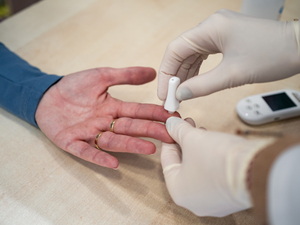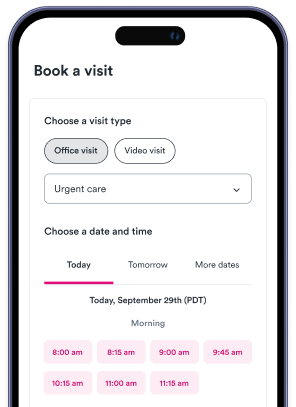Key points
- Daycares are high-contact environments where illnesses like Hand, Foot, and Mouth Disease, Respiratory Syncytial Virus, Pink Eye, Stomach Flu, and Ear Infections easily spread.
- These illnesses are typically spread through saliva, nasal secretions, contact with contaminated surfaces, and shared toys or utensils.
- While there's no specific medication for many of these illnesses, supportive care like rest, hydration, and over-the-counter pain relievers can help manage symptoms.
- Parents can reduce a child's risk of illness by teaching good hand hygiene, regularly disinfecting toys and surfaces, ensuring vaccinations are up-to-date, and prioritizing healthy habits like sleep and a balanced diet.

If your little one has started daycare, you’ve probably already noticed: sniffles, coughs, and stomach bugs seem to make the rounds on repeat. It’s no surprise—daycares are high-contact environments where curious hands, shared toys, and close quarters make it easy for germs to spread. Especially during peak cold, flu, or allergy seasons, it can feel like your child is constantly catching something new.
While it’s frustrating (and exhausting), frequent illness in young children is actually a normal part of building a stronger immune system. That said, knowing which bugs are going around—and how to manage or prevent them—can make a big difference in how your family copes. Here's a closer look at the most common daycare illnesses right now and what you can do to keep your child comfortable, safe, and on the mend.
1. Hand, Foot, and Mouth Disease
Hand, Foot, and Mouth Disease (HFMD) is a highly contagious viral illness most commonly caused by the coxsackievirus, according to the CDC. It primarily affects infants and young children, especially in group care settings like daycares, where close contact and shared surfaces are common.
Common symptoms of HFMD:
Fever and sore throat
Painful mouth sores that may make eating difficult
Rash or small blisters on the hands, feet, and sometimes the buttocks
How HFMD spreads
HFMD spreads easily through saliva, nasal secretions, fluid from blisters, stool, and contaminated hands or surfaces. It’s especially contagious during the first few days of illness, even before the rash appears.
How HFMD is treated
There’s no specific medication for HFMD, but supportive care can help manage symptoms. Encourage plenty of rest and fluids to prevent dehydration, especially if mouth sores make eating painful. Over-the-counter pain relievers, such as acetaminophen or ibuprofen, can help ease discomfort. Soft, cool foods like yogurt, smoothies, and popsicles may be easier for kids to tolerate until symptoms improve.
2. Respiratory Syncytial Virus (RSV)
RSV, or Respiratory Syncytial Virus, is one of the most common causes of respiratory infections in infants and young children, according to the CDC. While it often causes mild cold-like symptoms in older kids and adults, RSV can lead to more serious complications like bronchiolitis or pneumonia in babies, especially those under 12 months or with underlying health conditions.
Common symptoms of RSV include
Runny nose, coughing, sneezing, and wheezing
Fever
Difficulty breathing or rapid, shallow breaths
How does RSV spread
RSV is highly contagious and spreads through respiratory droplets, as well as from shared toys, surfaces, and unwashed hands, making daycares a prime setting for outbreaks.
How is RSV treated?
There’s no antiviral medication for RSV, so treatment focuses on supportive care. Keep your child well-hydrated and ensure they get plenty of rest. Use a humidifier to ease breathing, nasal suctioning (such as with a bulb syringe) to clear mucus in infants, and fever reducers like acetaminophen or ibuprofen if necessary.
When to visit urgent care for RSV symptoms
Seek urgent care if your child shows signs of respiratory distress, such as wheezing, chest retractions (when the skin pulls in between ribs while breathing), refusal to eat, or a persistent high fever. Prompt evaluation can help prevent more serious complications and provide guidance for at-home monitoring.
3. Pink Eye (Conjunctivitis)
Pink eye, or conjunctivitis, is an inflammation of the thin membrane that lines the white part of the eye and inner eyelid. It can be caused by viruses, bacteria, or allergens, and is particularly common in daycare settings due to frequent hand-to-eye contact and the sharing of toys.
Common symptoms of pink eye include:
Red, itchy, or watery eyes
Crusting around the eyelids, especially after sleep
Yellow or green discharge, depending on the cause
How does pink eye spread?
Pink eye spreads easily through direct contact with eye secretions or contaminated objects like towels, pillowcases, and toys. Children may unknowingly touch their eyes and then touch shared surfaces, quickly passing the infection along.
How is pink eye treated?
Treatment depends on the cause. Bacterial conjunctivitis is usually treated with prescription antibiotic eye drops or ointment. Viral conjunctivitis requires supportive care—cool compresses, artificial tears, and good hygiene. Allergic conjunctivitis is managed with allergy medications or antihistamine eye drops.
When to visit urgent care for pink eye symptoms
See an urgent care provider if your child’s eye becomes very swollen, painful, or starts producing thick pus. You should also seek care if symptoms worsen or don’t improve after 24–48 hours. Quick diagnosis helps prevent the spread to others and ensures the right treatment is started.
4. Stomach Flu (Gastroenteritis)
Gastroenteritis, often called the stomach flu, is a viral infection that causes inflammation of the stomach and intestines. It's commonly caused by norovirus or rotavirus and can spread rapidly in daycare environments due to shared spaces and frequent hand-to-mouth contact.
Common symptoms of the stomach flu include:
Vomiting and diarrhea
Stomach cramps
Low-grade fever
Fatigue or irritability
How the stomach flu spreads
The virus spreads through contaminated food, water, surfaces, or direct contact with someone who’s infected. Young children are particularly vulnerable because they often touch their faces or share utensils and toys.
How to treat the stomach flu at home
There’s no specific medication to cure viral gastroenteritis, so treatment focuses on supportive care. Offer oral rehydration fluids or clear liquids frequently to prevent dehydration. A bland diet—like bananas, rice, applesauce, and toast—is gentle on the stomach. Avoid dairy products and sugary drinks, as they can make symptoms worse. Let your child rest as much as possible.
When to visit urgent care for stomach flu symptoms
Seek care if vomiting or diarrhea lasts more than 24 hours, or if you notice signs of dehydration such as dry mouth, very little urine output, sunken eyes, or lethargy. Quick evaluation can help rule out more serious causes and ensure your child stays safely hydrated.
5. Ear Infections
Ear infections are one of the most common reasons young children visit the doctor, especially during or after a cold. These infections affect the middle ear and often develop when fluid builds up behind the eardrum after an upper respiratory virus. In daycare settings, where kids are frequently exposed to colds and other respiratory bugs, ear infections can spread indirectly as a secondary complication.
Common symptoms of ear infections include:
- Ear pain or discomfort
- Fussiness or increased crying
- Trouble sleeping or lying flat
- Fever
- Tugging at the ear
- Fluid or pus-like drainage from the ear
How ear infections can spread
While ear infections themselves aren’t contagious, they often follow viral infections that are. Respiratory illnesses circulating in daycare environments can lead to inflammation and fluid buildup, creating the perfect environment for an ear infection to develop.
How are ear infections treated?
Mild ear infections may clear up on their own within a few days. In the meantime, over-the-counter pain relievers (like acetaminophen or ibuprofen) and warm compresses can help ease discomfort. If a bacterial infection is suspected, an urgent care provider may prescribe antibiotics, especially for infants or cases involving persistent symptoms.
When to visit urgent care for ear infection symptoms
Bring your child to urgent care if they have significant ear pain that lasts more than 24 hours, develop a fever, or if fluid is draining from the ear. Prompt evaluation can help alleviate pain quickly and prevent complications, such as hearing loss or recurrent infections.
Prevention tips for parents
Prevention tips for parents
While you can’t prevent every daycare illness, there are several steps you can take to reduce your child’s risk and help them recover faster when they do get sick. Start by teaching and modeling good hand hygiene—encourage kids to wash their hands with soap and water before meals, after using the bathroom, and after blowing their nose. Keep children home when they’re sick until they’re fever-free and symptom-free for at least 24 hours to prevent spreading illness to others.
At home, regularly disinfect toys, high-touch surfaces, and items that travel between daycare and home (like pacifiers or sippy cups). Make sure your child is up to date on all recommended vaccines, including seasonal flu and COVID-19 shots where applicable, as these offer strong protection against severe illness. Finally, help build their immune system naturally by prioritizing sleep, keeping them well-hydrated, and offering a balanced diet rich in fruits, vegetables, and whole grains. Small, consistent efforts go a long way in keeping your child—and others—healthy.
Find urgent care near you for daycare illnesses
When your child picks up yet another bug from daycare, getting quick care shouldn’t be a hassle. Use Solv to find and book urgent care visits with same-day availability and kid-friendly providers who understand little patients. Whether it’s a lingering cough, pink eye, or a sudden fever, Solv makes it easy to get the help you need—fast, convenient, and stress-free.
FAQs
What are the common illnesses that spread in daycares?
The common illnesses that spread in daycares are Hand, Foot, and Mouth Disease (HFMD), Respiratory Syncytial Virus (RSV), Pink Eye (Conjunctivitis), Stomach Flu (Gastroenteritis), and Ear Infections.
How can I prevent my child from getting sick in daycare?
You can reduce your child's risk of getting sick by teaching and modeling good hand hygiene, keeping them home when they're sick until they're symptom-free for at least 24 hours, regularly disinfecting toys and high-touch surfaces, ensuring they are up to date on all recommended vaccines, and helping build their immune system naturally by prioritizing sleep, hydration, and a balanced diet.
What are the symptoms of Hand, Foot, and Mouth Disease (HFMD)?
The symptoms of HFMD include fever and sore throat, painful mouth sores that may make eating difficult, and rash or small blisters on the hands, feet, and sometimes the buttocks.
What should I do if my child shows symptoms of Respiratory Syncytial Virus (RSV)?
If your child shows signs of respiratory distress, such as wheezing, chest retractions, refusal to eat, or a persistent high fever, you should seek urgent care. Prompt evaluation can help prevent more serious complications and provide guidance for at-home monitoring.
How are ear infections treated?
Mild ear infections may clear up on their own within a few days. Over-the-counter pain relievers and warm compresses can help ease discomfort. If a bacterial infection is suspected, an urgent care provider may prescribe antibiotics, especially for infants or cases involving persistent symptoms.









